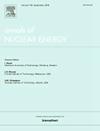Research and Validation of the Monte Carlo-based multi-cycle neutronic Simulations methodology for HFETR
IF 1.9
3区 工程技术
Q1 NUCLEAR SCIENCE & TECHNOLOGY
引用次数: 0
Abstract
The High Flux Engineering Test Reactor (HFETR) is a distinctive reactor that exhibits notable differences in design and operational characteristics compared to commercial pressurized water reactors. The reactor is distinguished by a sophisticated core composition, an adaptable core loading configuration, and pronounced heterogeneity. In order to achieve this, the RMC Monte Carlo transport-burnup coupling code was employed. The developers constructed a sophisticated computational model to simulate global core and localized fuel irradiation. This model effectively captures the physical dynamics of the core across multiple loops, incorporating a range of variables, including fuel burnup, control rod positioning, beryllium poisoning, and particle transport during reactor operations. The methodology comprises comprehensive refueling and fuel management calculations for an array of fuel types and burnable poisons, coupled with the formulation of a multi-cycle neutronic calculation framework. An evaluation of core reactivity and average point burnup for different fuel irradiation cycles reveals a high alignment between the calculated and experimental data, with an average relative error below 1000 pcm and 10%. This outcome provides substantial evidence supporting the accuracy of the HFETR multi-cycle neutronic simulation methodology.
求助全文
约1分钟内获得全文
求助全文
来源期刊

Annals of Nuclear Energy
工程技术-核科学技术
CiteScore
4.30
自引率
21.10%
发文量
632
审稿时长
7.3 months
期刊介绍:
Annals of Nuclear Energy provides an international medium for the communication of original research, ideas and developments in all areas of the field of nuclear energy science and technology. Its scope embraces nuclear fuel reserves, fuel cycles and cost, materials, processing, system and component technology (fission only), design and optimization, direct conversion of nuclear energy sources, environmental control, reactor physics, heat transfer and fluid dynamics, structural analysis, fuel management, future developments, nuclear fuel and safety, nuclear aerosol, neutron physics, computer technology (both software and hardware), risk assessment, radioactive waste disposal and reactor thermal hydraulics. Papers submitted to Annals need to demonstrate a clear link to nuclear power generation/nuclear engineering. Papers which deal with pure nuclear physics, pure health physics, imaging, or attenuation and shielding properties of concretes and various geological materials are not within the scope of the journal. Also, papers that deal with policy or economics are not within the scope of the journal.
 求助内容:
求助内容: 应助结果提醒方式:
应助结果提醒方式:


